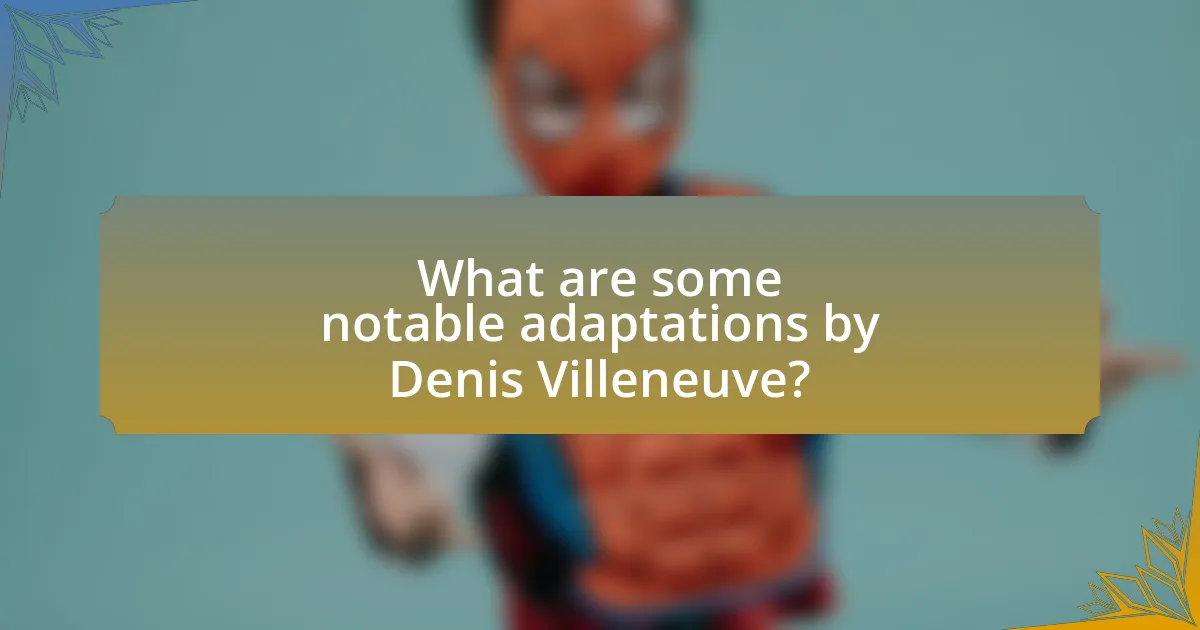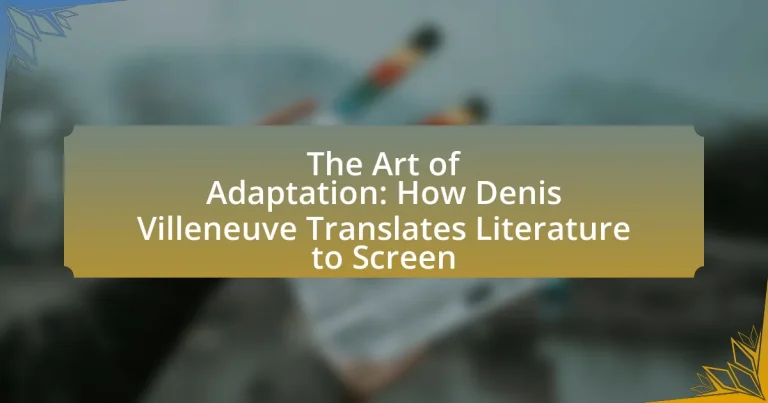The article focuses on the art of adaptation in film, specifically examining how Denis Villeneuve successfully translates literary works into cinematic narratives. It outlines the key elements that define a successful adaptation, such as fidelity to the source material, character development, and thematic consistency. The article also discusses the challenges filmmakers face when adapting literature, the techniques Villeneuve employs to maintain the essence of the original works, and the themes he explores in his adaptations. Notable examples of Villeneuve’s adaptations, including “Dune” and “Arrival,” are highlighted to illustrate his unique approach and the impact of his work on contemporary cinema.

What is the Art of Adaptation in Film?
The Art of Adaptation in Film refers to the process of transforming a written work, such as a novel or play, into a cinematic narrative. This involves interpreting the source material’s themes, characters, and plot while making necessary adjustments to fit the visual and temporal constraints of film. Successful adaptations, like Denis Villeneuve’s work on “Dune,” demonstrate how filmmakers can maintain the essence of the original text while employing cinematic techniques to enhance storytelling. Villeneuve’s adaptation showcases fidelity to the source material through careful selection of key scenes and dialogue, while also utilizing visual storytelling to convey complex ideas, illustrating the balance between creativity and respect for the original work.
How does adaptation differ from original storytelling?
Adaptation differs from original storytelling in that it involves transforming existing narratives from one medium to another, while original storytelling creates entirely new narratives. Adaptations often reinterpret source material, such as novels or plays, to fit the visual and temporal constraints of film, which can lead to changes in character development, plot structure, and thematic emphasis. For instance, Denis Villeneuve’s adaptations, like “Dune,” illustrate how he condenses complex literary elements into a cinematic format, often prioritizing visual storytelling and pacing over the depth found in the original text. This process highlights the necessity of making creative choices that may alter the original intent or details of the source material to resonate with a new audience.
What are the key elements that define a successful adaptation?
Key elements that define a successful adaptation include fidelity to the source material, character development, thematic consistency, and effective pacing. Fidelity ensures that the core narrative and essential elements of the original work are preserved, which is crucial for maintaining the integrity of the story. Character development allows for deeper exploration of motivations and relationships, enhancing audience engagement. Thematic consistency ensures that the underlying messages and motifs of the original are effectively conveyed, resonating with both new and existing audiences. Effective pacing maintains viewer interest and allows for a coherent narrative flow, preventing the adaptation from feeling rushed or overly drawn out. These elements collectively contribute to the overall success of an adaptation, as evidenced by Denis Villeneuve’s acclaimed works, which often balance these aspects to create compelling cinematic experiences.
How do filmmakers choose which literary works to adapt?
Filmmakers choose literary works to adapt based on factors such as the story’s thematic depth, character complexity, and potential for visual storytelling. They often seek narratives that resonate with contemporary audiences or offer unique perspectives, as seen in adaptations like Denis Villeneuve’s “Dune,” which was chosen for its rich world-building and philosophical themes. Additionally, the popularity of the source material, critical acclaim, and the potential for a strong emotional connection with viewers also influence their decisions. For instance, adaptations of best-selling novels often attract attention due to established fan bases, increasing the likelihood of box office success.
Why is Denis Villeneuve significant in the realm of adaptation?
Denis Villeneuve is significant in the realm of adaptation due to his ability to translate complex literary works into visually compelling and thematically rich films. His adaptations, such as “Blade Runner 2049” and “Dune,” showcase a deep understanding of source material, maintaining the essence of the original narratives while enhancing them through cinematic techniques. Villeneuve’s meticulous attention to detail and his collaboration with talented screenwriters and production teams result in adaptations that resonate with both fans of the original works and new audiences. His films often explore profound philosophical themes, reflecting the depth of the literature he adapts, which has garnered critical acclaim and commercial success, solidifying his reputation as a master of adaptation.
What unique qualities does Villeneuve bring to his adaptations?
Denis Villeneuve brings a distinctive visual storytelling approach to his adaptations, characterized by meticulous attention to detail and atmospheric world-building. His films often emphasize emotional depth and philosophical themes, as seen in “Arrival,” where he explores complex concepts of time and communication. Villeneuve’s ability to balance grand cinematic visuals with intimate character development allows him to create a profound connection between the audience and the source material. Additionally, his collaboration with talented cinematographers and composers enhances the immersive experience, further solidifying his unique style in adapting literature to film.
How has Villeneuve’s background influenced his adaptation style?
Denis Villeneuve’s background as a filmmaker from Quebec has significantly influenced his adaptation style by instilling a deep appreciation for narrative complexity and emotional depth. His early exposure to diverse cultures and languages in Canada has shaped his ability to convey nuanced themes and character development, evident in adaptations like “Arrival” and “Dune.” Villeneuve’s focus on visual storytelling, combined with his understanding of literary sources, allows him to maintain the essence of the original material while enhancing it for cinematic experience. This approach is supported by his consistent collaboration with screenwriters and a meticulous attention to detail, ensuring that the adaptations resonate with both audiences and critics alike.
What challenges do filmmakers face when adapting literature?
Filmmakers face several challenges when adapting literature, primarily including the need to condense complex narratives into a limited runtime. This often results in the omission of subplots and character development, which can alter the original story’s essence. For instance, adaptations like “The Lord of the Rings” required significant changes to fit the cinematic format while attempting to maintain the core themes and character arcs from J.R.R. Tolkien’s extensive work. Additionally, filmmakers must navigate the expectations of both the original audience and new viewers, balancing fidelity to the source material with the demands of cinematic storytelling. This challenge is evident in adaptations such as “The Great Gatsby,” where visual representation and pacing can lead to different interpretations of key themes.
How do narrative structure and pacing affect adaptations?
Narrative structure and pacing significantly influence adaptations by shaping how the source material is interpreted and presented on screen. A well-defined narrative structure provides a clear framework that guides the audience through the story, ensuring that key themes and character arcs are effectively conveyed. For instance, Denis Villeneuve’s adaptation of “Dune” utilizes a nonlinear narrative to enhance the complexity of the plot, allowing viewers to grasp the intricate relationships and motivations of characters.
Pacing, on the other hand, affects the emotional engagement and tension within the adaptation. A deliberate pacing can build suspense and allow for character development, as seen in Villeneuve’s work, where moments of action are balanced with quieter, introspective scenes. This balance is crucial; studies show that adaptations that maintain a consistent pacing aligned with the original material often resonate more with audiences, preserving the essence of the source while making it accessible for film.
In summary, both narrative structure and pacing are essential in adaptations, as they determine how effectively the story is communicated and experienced by the audience.
What role do audience expectations play in the adaptation process?
Audience expectations significantly influence the adaptation process by shaping the creative decisions made by filmmakers. These expectations arise from prior knowledge of the source material, cultural context, and the emotional connections audiences have with the original work. For instance, when adapting a novel, filmmakers like Denis Villeneuve must consider how audiences anticipate character portrayals, plot developments, and thematic elements, as these factors can determine the success or failure of the adaptation. Research indicates that adaptations that align closely with audience expectations tend to perform better commercially and critically, as seen in adaptations like “Dune,” where Villeneuve balanced fidelity to the source material with cinematic innovation to meet audience desires.

How does Denis Villeneuve approach literary adaptations?
Denis Villeneuve approaches literary adaptations by prioritizing the essence and themes of the source material while infusing his unique visual style and narrative depth. He meticulously analyzes the core messages and emotional undercurrents of the original work, as seen in his adaptations of “Dune” and “Arrival,” where he captures the philosophical and existential themes present in Frank Herbert’s and Ted Chiang’s writings. Villeneuve collaborates closely with screenwriters and often emphasizes the importance of maintaining fidelity to the source material’s spirit, ensuring that the adaptation resonates with both fans of the original text and new audiences. His commitment to authenticity is evident in his detailed world-building and character development, which reflect the complexities of the literary works he adapts.
What techniques does Villeneuve use to translate text to screen?
Denis Villeneuve employs several techniques to translate text to screen, including visual storytelling, thematic focus, and character development. Visual storytelling is evident in his use of striking cinematography and composition to convey emotions and themes without relying solely on dialogue. For instance, in “Blade Runner 2049,” the expansive landscapes and detailed set designs reflect the film’s exploration of identity and humanity.
Thematic focus allows Villeneuve to distill complex narratives into core ideas that resonate with audiences. In “Dune,” he emphasizes the themes of power and ecological responsibility, aligning the film’s visuals and pacing with the source material’s philosophical underpinnings.
Character development is another crucial technique, where Villeneuve deepens characters through nuanced performances and backstory integration, as seen in “Arrival,” where the protagonist’s emotional journey is intricately tied to the film’s narrative structure. These techniques collectively enhance the adaptation process, ensuring that the essence of the original text is preserved while making it accessible to a cinematic audience.
How does he maintain the essence of the source material?
Denis Villeneuve maintains the essence of the source material by prioritizing its thematic depth and character development. He carefully analyzes the core messages and emotional arcs present in the original work, ensuring that these elements are preserved in his adaptations. For instance, in “Dune,” Villeneuve emphasizes the intricate political and ecological themes of Frank Herbert’s novel, translating them into a visually stunning narrative that resonates with contemporary audiences. His commitment to authenticity is further evidenced by his collaboration with the original authors or experts in the field, which helps to retain the integrity of the source material while adapting it for the screen.
What visual storytelling methods does Villeneuve employ?
Denis Villeneuve employs several visual storytelling methods, including meticulous framing, atmospheric lighting, and symbolic imagery. His use of framing often emphasizes character emotions and relationships, as seen in “Arrival,” where close-ups capture subtle expressions that convey complex feelings. Atmospheric lighting enhances mood and tension, particularly in “Blade Runner 2049,” where neon hues and shadows create a dystopian ambiance. Additionally, Villeneuve utilizes symbolic imagery to deepen narrative themes, such as the recurring motif of water in “Dune,” which signifies both life and transformation. These methods collectively enhance the emotional depth and thematic resonance of his adaptations.
How does Villeneuve handle character development in adaptations?
Denis Villeneuve handles character development in adaptations by deeply exploring the psychological and emotional complexities of characters, often prioritizing their internal struggles over external action. In films like “Dune” and “Arrival,” Villeneuve emphasizes character arcs that reflect personal growth and moral dilemmas, allowing audiences to connect with their journeys on a profound level. For instance, in “Dune,” Paul Atreides’ transformation from a reluctant heir to a decisive leader is portrayed through nuanced interactions and introspective moments, showcasing Villeneuve’s commitment to character depth. This approach is validated by critical acclaim, as both films received praise for their character-driven narratives, highlighting Villeneuve’s skill in translating literary depth to the screen.
What strategies does he use to deepen character arcs?
Denis Villeneuve deepens character arcs through meticulous character development, emotional resonance, and visual storytelling. He emphasizes backstory and motivation, allowing audiences to understand characters’ complexities and transformations. For instance, in “Arrival,” Villeneuve explores the protagonist’s emotional journey through her interactions and choices, which are intricately tied to the film’s themes of communication and loss. This approach not only enhances character depth but also aligns with the narrative’s emotional stakes, making the characters’ arcs more impactful and relatable.
How does he balance fidelity to the source with creative interpretation?
Denis Villeneuve balances fidelity to the source with creative interpretation by meticulously analyzing the core themes and emotional truths of the original material while allowing for visual and narrative innovation. He often retains key plot points and character arcs to honor the source, as seen in his adaptation of “Dune,” where he preserved Frank Herbert’s intricate world-building and philosophical underpinnings. Simultaneously, Villeneuve employs cinematic techniques, such as visual storytelling and pacing adjustments, to enhance the narrative experience, demonstrating his ability to reinterpret the source material for a modern audience without losing its essence.
What themes does Villeneuve explore in his adaptations?
Denis Villeneuve explores themes of identity, existentialism, and the human condition in his adaptations. In “Arrival,” he delves into the complexities of communication and time, emphasizing how language shapes perception and reality. “Dune” examines power dynamics, ecological concerns, and the hero’s journey, reflecting on the consequences of imperialism and resource exploitation. Villeneuve’s adaptations often highlight the struggle between personal desires and larger societal forces, showcasing the intricate relationship between individuals and their environments.
How do these themes resonate with contemporary audiences?
Denis Villeneuve’s themes resonate with contemporary audiences by addressing universal human experiences such as identity, conflict, and existentialism. These themes reflect the complexities of modern life, where individuals grapple with their sense of self in an increasingly fragmented world. For instance, Villeneuve’s adaptation of “Dune” explores the struggle for power and the consequences of destiny, mirroring current societal issues like climate change and political unrest. This relevance is supported by audience engagement metrics, such as box office success and critical acclaim, indicating that viewers find these themes relatable and thought-provoking.
What recurring motifs can be identified across his works?
Recurring motifs identified across Denis Villeneuve’s works include themes of isolation, the complexity of human emotion, and the exploration of time and memory. In films like “Arrival,” the motif of communication barriers highlights isolation, while “Blade Runner 2049” delves into the intricacies of human identity and emotional depth. Additionally, “Dune” presents a cyclical understanding of time and destiny, reinforcing the significance of memory in shaping characters’ journeys. These motifs are consistently woven throughout his filmography, demonstrating Villeneuve’s focus on profound human experiences and existential questions.

What are some notable adaptations by Denis Villeneuve?
Denis Villeneuve is known for notable adaptations such as “Arrival,” based on Ted Chiang’s short story “Story of Your Life,” and “Dune,” adapted from Frank Herbert’s seminal science fiction novel. “Arrival” received critical acclaim for its innovative storytelling and exploration of language and time, while “Dune” was praised for its visual grandeur and fidelity to the source material, becoming a significant box office success and winning multiple Academy Awards. These adaptations showcase Villeneuve’s ability to translate complex narratives into compelling cinematic experiences.
How does “Dune” exemplify Villeneuve’s adaptation style?
“Dune” exemplifies Denis Villeneuve’s adaptation style through its meticulous attention to world-building and character depth. Villeneuve employs a visual storytelling approach that captures the intricate details of Frank Herbert’s universe, utilizing expansive cinematography and a carefully crafted score to enhance the narrative. For instance, the film’s use of practical effects and real locations creates an immersive experience that aligns closely with the source material’s themes of ecology and politics. Additionally, Villeneuve’s focus on character development, particularly through the portrayal of Paul Atreides, reflects his commitment to preserving the emotional core of the original text, allowing audiences to connect deeply with the characters. This fidelity to the source material, combined with innovative cinematic techniques, showcases Villeneuve’s unique ability to translate complex literature into a compelling visual format.
What challenges did he face in adapting Frank Herbert’s novel?
Denis Villeneuve faced significant challenges in adapting Frank Herbert’s novel “Dune,” primarily due to the complexity of the source material. The novel’s intricate world-building, extensive lore, and multifaceted characters required careful distillation to fit a cinematic format. Additionally, Villeneuve had to balance the novel’s philosophical themes with the demands of mainstream storytelling, ensuring that the film remained accessible to a broad audience while staying true to Herbert’s vision. The need to condense a lengthy narrative into a manageable runtime further complicated the adaptation process, necessitating the selection of key plot points and character arcs that would resonate with viewers.
How did he visually interpret the world of “Dune”?
Denis Villeneuve visually interpreted the world of “Dune” by employing a blend of vast landscapes, intricate set designs, and a distinct color palette that reflects the novel’s themes. He utilized expansive desert vistas to convey the scale and isolation of the planet Arrakis, while the detailed architecture of the structures, such as the imposing citadel of Arrakeen, emphasizes the cultural depth of the universe. Villeneuve’s choice of muted earth tones, contrasted with vibrant hues for the spice, enhances the visual storytelling, making the environment feel both alien and familiar. This approach is validated by the film’s critical acclaim for its cinematography, which captures the essence of Frank Herbert’s intricate world, as noted in reviews from sources like Variety and The Hollywood Reporter.
What makes “Arrival” a standout adaptation?
“Arrival” is a standout adaptation due to its profound exploration of language and communication, which is central to Ted Chiang’s short story “Story of Your Life.” Denis Villeneuve effectively translates the intricate themes of time perception and human connection from the written word to the screen, utilizing innovative visual storytelling techniques. The film’s non-linear narrative mirrors the story’s exploration of time, allowing viewers to experience the protagonist’s journey in a way that reflects the complexities of understanding alien language. This approach not only honors the source material but also enhances its emotional depth, making the adaptation resonate with audiences on multiple levels.
How does Villeneuve convey complex themes through a sci-fi narrative?
Denis Villeneuve conveys complex themes through a sci-fi narrative by integrating philosophical questions and emotional depth into his storytelling. For instance, in “Arrival,” he explores themes of communication and time perception, using the alien language as a metaphor for understanding and connection. This narrative choice illustrates how language shapes reality and human experience, emphasizing the importance of empathy. Additionally, in “Dune,” Villeneuve addresses themes of power, ecology, and destiny, reflecting on the consequences of imperialism and environmental exploitation. The intricate world-building and character development in these films serve to engage viewers with these profound themes, making them accessible within the sci-fi genre.
What techniques does he use to build suspense and emotional depth?
Denis Villeneuve employs techniques such as pacing, visual storytelling, and character development to build suspense and emotional depth. He meticulously controls the rhythm of the narrative, often using slow reveals and tension-filled moments to keep audiences on edge. For instance, in “Arrival,” the gradual unveiling of the aliens’ intentions creates a sense of suspense while simultaneously deepening the emotional connection to the protagonist’s personal journey. Additionally, Villeneuve’s use of striking visuals and atmospheric sound design enhances the emotional weight of scenes, as seen in “Blade Runner 2049,” where the desolate landscapes reflect the characters’ internal struggles. These techniques effectively engage viewers, making them invested in both the plot and the characters’ emotional arcs.
What lessons can be learned from Villeneuve’s adaptations?
Villeneuve’s adaptations teach the importance of fidelity to source material while also embracing creative interpretation. His films, such as “Dune” and “Arrival,” demonstrate that staying true to the core themes and emotional depth of the original works can resonate with audiences, as seen in the critical acclaim and box office success of these films. Additionally, Villeneuve’s use of visual storytelling and pacing highlights the necessity of translating literary elements into cinematic language effectively, ensuring that the essence of the narrative is preserved while making it accessible for viewers.
How can aspiring filmmakers apply Villeneuve’s techniques to their own work?
Aspiring filmmakers can apply Denis Villeneuve’s techniques by focusing on meticulous world-building, character depth, and visual storytelling. Villeneuve emphasizes creating immersive environments that enhance narrative, as seen in “Blade Runner 2049,” where the setting reflects the emotional landscape of the characters. Filmmakers should invest time in developing complex characters with rich backstories, similar to how Villeneuve portrays nuanced relationships in “Arrival.” Additionally, they can adopt his approach to visual composition, utilizing cinematography to convey themes and emotions, as demonstrated in “Dune,” where framing and color palettes serve to enhance the story’s epic scale. By integrating these elements, filmmakers can create compelling adaptations that resonate with audiences.
What best practices should be considered when adapting literature to film?
When adapting literature to film, it is essential to maintain the core themes and character arcs while making necessary adjustments for the visual medium. This involves identifying the central narrative and emotional beats of the source material, ensuring that they resonate with the audience through visual storytelling techniques. For example, Denis Villeneuve’s adaptations often focus on the emotional depth of characters, which is crucial for audience engagement. Additionally, filmmakers should consider pacing, as literature allows for more introspection and detail, while film requires a more streamlined narrative to maintain viewer interest. The successful adaptation of “Dune” illustrates this, where Villeneuve effectively condensed complex plotlines while preserving the essence of Frank Herbert’s work. Ultimately, balancing fidelity to the source material with the demands of cinematic storytelling is a best practice that enhances the adaptation’s effectiveness.


